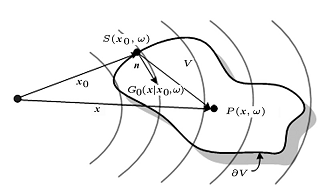From the listener’s perspective, sound intensity and DRR decrease when the source is moving away from the listener. In order to properly reproduce the sound source distance in room environment, it is essential to make the DRR and intensity change according to the real case. Although implementing changes in intensity is quite easy, providing realistic changes in DRR is quite demanding.
In order to synthesize distance perception of the sound source, researchers from the Institute of Acoustics, Chinese Academy of Sciences introduce the image method into Helmholtz integral equation. That is used in Wave Field Synthesis (Fig.1) to derive the proper driving functions of secondary sources. The proposed method has achieved providing realistic changes in DRR which is quite demanding in sound reproduction. Numerical calculations and subjective audio tests have been presented to demonstrate the effect of the method.

Fig. 1. Illustration of the principle used for wave field synthesis (Image by Huygens).
The contribution of this research is that it provides a novel method which offers a more authentic acoustic experience to the listeners, producing departing sound as real as possible.
The research is supported by the National Natural Science Foundation of China (No.11161140319). Entitled “Synthesis of Perceived Distance in Wave Field Synthesis”, it has been published in Chinese Journal of Electronics (Vol.22, No.3, July 2013) with the URL:http://www.ejournal.org.cn/Jweb_cje/EN/.
Contact:
LI Juan, YAN Yonghong
Key Laboratory of Speech Acoustics and Content Understanding, Institute of Acoustics, Chinese Academy of Sciences, Beijing 100190, China


